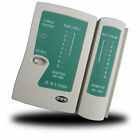9
2
This question is basically a continuation of this previous question. Never mind, here's the deal:
I've made a LAN cable that goes through a wall, but it doesn't work. The cable is roughly 10m/30ft long. I crimped both ends myself according to this detailed explanation, and the job looks to be well done; all the wires are all the way in the plug.
I bought a cable tester after not being able to fix this. I thought perhaps the cable  has a bad kink somewhere. But the cable tester says all wires are okay! The cable tester flashes its lights nicely in the correct sequence. According to the half-chinese instruction page, this indicates that everything is wired correctly. Even if I might have the wrong color sequence, the copper itself seems to be correct.
has a bad kink somewhere. But the cable tester says all wires are okay! The cable tester flashes its lights nicely in the correct sequence. According to the half-chinese instruction page, this indicates that everything is wired correctly. Even if I might have the wrong color sequence, the copper itself seems to be correct.
But when I unplug the LAN cable sneaking through the hallways, and connect this new LAN cable instead, Windows reports that there's no network.
What can be wrong? How can I find out?
Updated: Italic text above, in response to the first few answers.
1Do you get a link light on the NICs? Are the individual conductors in the same order as the known-good cable, taking into account all four plugs? Do you have another piece of cable left over (even if it's relatively short) and a couple of extra plugs? Make up another cable, test it with your tester, test it between two devices. – Paused until further notice. – 2010-09-20T20:30:45.433
1Just to be clear, you are not trying to connect PC to PC, correct? – Beaner – 2010-09-20T21:17:17.877
@Beaner, I am connecting pc to router, not pc to pc. – Torben Gundtofte-Bruun – 2010-09-21T06:02:58.317